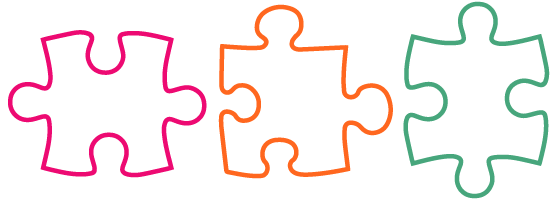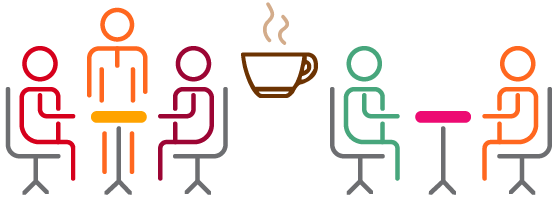
Collaborative Activities for Online Learning
Authors: Lorelei Anselmo, Patrick Kelly, Lin Yu, and Haboun Bair
Collaborative learning is an opportunity for students and instructors to engage in shared efforts to search for meaning, understanding, and solutions to complex problems or concepts.
This learning relationship invites the instructor to facilitate active learning strategies and activities that encourage students to interact with others and share their diverse perspectives to explore course material and their own experiences in multiple ways.
Using collaborative learning activities to promote active and emergent work within a course can help instructors support students in articulating and applying their learning alongside course lectures and extend meaningful discussions inside and outside of the classroom.
Collaborative learning activities and approaches vary in the amount of in-class and out-of-class time built around collaboration. The following activities can be used in any discipline and modified to suit any course context.
Related content
Keeping Students on Track in Online Courses
Strategies for Promoting Positive Learning Environments
Learning Module: Managing Student Team Projects
Four Corners

Four Corners is an activity that helps students make connections to course material, research ideas, and explain their own decisions and thought process. This activity can be used to activate students’ prior knowledge, research a topic, debate a controversial activity, share differing perspectives, and build relationships.
- Zoom main room - Present the instructions in the main Zoom room, and then set up 4 breakout rooms for each ‘corner’ and use the “Let participants choose room” option. Refer to the breakout room window to see how many students are in each room, and then rotate through each room to ensure students are on track.
- Zoom breakout room - Students discuss why they picked their ‘corner’, and collaborate to summarize, problem-solve, and reflect on their discussion. They can record their work on a Google document or Google slide for later reference.
- After the Zoom session - Students can continue to prepare their summary or presentation to share with the class.
- D2L discussions - Students post their presentation or summary for all students to view.
- Individually, students can submit their reflection on the experience with questions such as:
- What thoughts or ideas did they come away with after the Four Corners activity?
- What learning happened after sharing their ideas with their peers in D2L?
- Have a 4-corner debate where the corners are labeled strongly agree, agree, disagree and strongly disagree. The instructor poses a topic or questions, and students select a corner, prepare their statement, their reasoning, and then present to the class.
- Randomly assign students to each corner and then pose multiple choice or open-ended questions to each corner for the students to solve. This could even be made into a competition for exam review. Ask the students to explain the Why behind their answers.
- Host the presentations in Zoom, and individual students can submit a summary that includes information from all presentations.
Yee, K. (2020). Interactive Techniques. https://www.usf.edu/atle/documents/handout-interactive-techniques.pdf
The teacher toolkit. Four corners. https://www.theteachertoolkit.com/index.php/tool/four-corners
Jigsaw

The jigsaw activity is a collaborative technique where one student or group of students researches a certain topic and then teaches this topic to other students. This technique promotes research, problem solving, communication and cooperation skills.
- Select a reading, topic or question that can be divided into smaller, interconnect ‘buckets’.
- Zoom main room - Present the buckets to students. Assign a bucket to each student or small group. If using groups create breakout rooms. Give the students some time to review their bucket and plan how they will prepare.
- Zoom - Students can begin researching their topic and preparing a presentation to report to their group or class.
- Outside of class - Students continue to research and prepare their presentation. A presentation could be written or visual.
- D2L - Students can post their presentation into D2L discussions and then continue to have class discussions on the topic. Students can combine all the topics presented and write a summary piece to submit as an assignment.
TIP: Use Google documents or Google slides and assign students to take notes to create a comprehensive document on the topic.
- If the topic has 4 buckets to research, create groups of 4 students and assign a bucket to each student. Group members then teach one another and individually summarize the topic. This can be done in a Zoom breakout room or in a D2L discussion.
- A group researches 1 bucket and then 1 student rotates to another group, learns about the new bucket, and then reports back to their own group to collect all buckets.
- Each group creates a poster (in Google documents or Google Slides), then all groups rotate through each poster in gallery walk style where the owner of the poster gives a 2-minute overview. Individual groups/students then need to compile their findings.
Yee, K. (2020). Interactive Techniques. https://www.usf.edu/atle/documents/handout-interactive-techniques.pdf
Visual Prompt

The Visual Prompt guides students through a close analysis of an image. Through this learning activity, students develop awareness of context, expand critical thinking skills, enhance their observation and interpretive skills, and establish conceptual learning techniques. You can use this strategy with any visual media, including a piece of art, photograph, political cartoon, propaganda poster, or video clip.
- Select an image that lends itself to deep analysis by students. Share the image in the main Zoom room.
- Ask students to look intentionally at the picture. Have them observe shapes, colours, textures, the position of people and/or objects, etc.
- Have students write down what they see without making any interpretation about what the picture is trying to say.
- Ask students: What questions do you have about this picture that you would need to have answered before you can begin to interpret it? Each student should prepare 1-2 questions.
- In breakout rooms, have students discuss their questions with other students in the class to try to find some answers. Ask groups to nominate a spokesperson for the group.
- Bring students back from breakout rooms, discuss questions and answer as a group.
- In D2L in a discussion board thread, given the context and subject of the piece, ask students what they think the artist is trying to say (what does the piece mean), and who they think is the intended audience?
- Introduce the image in D2L discussions. In pairs (or groups) ask students to create questions for other pairs (or groups) to answer. Questions should be based on see/think/wonder themes. Students then create a dialogue or conversation based on what they see/think/wonder is happening in the image according to the context. These dialogues could be shared during a Zoom session. Students then compare different interpretations of the image.
- Introduce the image in the Zoom main room. Don’t reveal the title or context. Provide students with a link to an “Intriguing Image: See, Think, Wonder” Google Doc, Google Jamboard or three columns in the chat box or whiteboard. Model the strategy by typing in a few ideas for each column. Then place students in breakout rooms and let them complete the columns together and create a title for the image. The columns and title are then shared in D2L with each group having their own thread. Groups comment on each other’s columns and titles.
Facing History and Ourselves. (n.d.). Picture This. Retrieved February 12, 2021, from https://www.facinghistory.org/resource-library/back-school-2020-building-community-connection-and-learning/establishing-opening-closing-routines/picture-this
Guided Notes

Guided Notes are instructor (or student) prepared notes that outline lectures, presentations, or readings, but leave blank space for students to fill in key concepts, facts, definitions, etc. Guided Notes promote active engagement during lecture or independent reading, provide full and accurate notes for use as a study guide, and help students to identify the most important information covered.
- Upload a set of partial notes from a module with critical contextual information and/or examples missing or incomplete into D2L.
- In pairs/groups students use information from course readings, lectures (live and/or recorded), links and other required material from a specific module to complete the guided notes.
- Students in their pairs or groups compare notes outside of class.
- Students submit their guided notes to Dropbox prior to the next Zoom session and nominate one person to present their notes.
- In Zoom, one member of each group, presents one section of the guided notes. During the Zoom session, the instructor reviews the notes, and students correct/edit where necessary.
- In pairs or groups, students take turns (either by week, module or unit) depending on how the course is structured, creating guided notes based on one essential reading from that topic. The pair/group would post their guided notes in D2L and would be responsible for responding to posts on the discussion board from other groups. The completed guided notes would be shared in a Zoom session, discussed with the instructor and then later posted to D2L.
Stanford University Tomorrow’s Professor Posting. Guided Notes - Improving the Effectiveness of Your Lectures. Tomorrow’s Teaching and Learning. https://tomprof.stanford.edu/posting/495
The teacher toolkit. Guided Notes. https://www.theteachertoolkit.com/index.php/tool/guided-notes
Iceberg Diagram

With an iceberg, only its tip is visible above the water while the bulk of it is invisible below the water’s surface. The iceberg theory implies that information or date that is important could be hidden for the proper evaluation of an event, a problem, or a situation. The iceberg diagram teaching strategy prompts students to look deeper than the surface in order to gain awareness of the numerous underlying causes that give rise to a concept, event, topic or situation.
- Select a concept, event, topic or situation the class is exploring.
- Zoom main room - Introduce the iceberg visual. Ask students to list what they know about icebergs (in chat or using microphones) or show them a picture of an iceberg - (on main Zoom page). The main idea you want to establish is that what one sees above the water is only the tip of the iceberg, the larger foundation rests below the surface. Include an iceberg diagram template in the presentation slides or the whiteboard.
- Breakout rooms - The tip of the iceberg – before sending students to breakout rooms, explain the discussion task and copy the questions in the chat. In the breakout rooms, students brainstorm and list everything they know about the facts of a selected concept, event, topic or situation in the “tip” area of the iceberg. Example questions could be: What happened? What choices were made in this situation? By whom? Who was affected? When did it happen? Where did it happen?
- Zoom main room - Students debrief their Tip of the Iceberg findings. Step 3 could be repeated to discuss what is beneath the surface or continue this activity in D2L.
- D2L discussion groups: Beneath the surface - Create discussion groups in D2L. Keep the same groups as in the breakout rooms and outside of class in D2L to complete the iceberg. Ask students to discuss what caused this concept, event, topic or situation. In the bottom part of the iceberg (under the water), the students should write answers to the question, “What factors influenced the particular choices made by the individuals and groups involved in this concept, event, topic or situation ?”
- D2L Discussions – Create a discussion topic that is open to the whole class. Ask one representative from each group to upload their completed iceberg diagrams to the discussion board for feedback from peers and the instructor.
- An evaluation tool - diagrams could be uploaded to Dropbox. Students could write an essay explaining the ideas in the bottom part of the iceberg.
- Comparing concepts, events, topics or situations - students could have different concepts, events, topics or situations that they are comparing and present their icebergs on Zoom. This could help students recognize patterns or the uniqueness of each concept, event, topic or situation.
- Current concept, event, topic or situation - could use the iceberg template to investigate a current concept, event, topic or situation of the students’ choosing. The students would work in groups and complete an iceberg diagram for their chosen concept, event, topic or situation. Then present their iceberg diagram in Zoom or in D2L by recording their thoughts and explanations of what they think caused the concept, event, topic or situation.
Facing History and Ourselves. Iceberg Diagrams. https://www.facinghistory.org/resource-library/teaching-strategies/iceberg-diagrams
World Café

The World Café is a structured conversational process for knowledge sharing in which groups discuss a topic at several small tables like the setting in a café. This method fosters a relaxing and informal environment that develops collaborative dialogues around questions that matter to generate innovative ideas.
- Setting: instead of small round tables with chairs, prepare online spaces for students to gather such as Google Jamboard or Google slides with guiding questions on each board or slide.
- Welcome and introduction: In the main room - begin with a warm welcome and an introduction to the World Café process, sharing the Café Etiquette and learning outcomes.
- Zoom main room: setting the context. Present the course content. Introduce the questions that are crafted for the course topics and desired outcomes of the World Café. You may use the same question for one or more rounds of conversation, or you may pose different questions in each round to build on and help deepen the exploration.
- Breakout rooms: Questions – in small groups, students start discussing the question posted in their designated Google Jamboard/slides for approximately 20 minutes. Upon completing the initial round of conversation, the same group of students moves on to the next board in line to discuss a different question. Ask students to jot down their key ideas or add new ideas on each board. Providing opportunities for students to move in several rounds of conversation, ideas, questions, and themes allows students to link and connect their thoughts. In the last round of conversation, students can return to their first board/slide to synthesize their discussions, or they may continue viewing notes rotating through in a Gallery walk style.
- Zoom main room: After at least three rounds of conversation, initiate a period of sharing discoveries and insights in a whole group conversation. One spokesperson from each group will present their key learning. At the end of the session, students may take five minutes to reflect on how their thinking shifted with new discoveries and collective knowledge expansion.
- Move the World Café to D2L discussions. Create groups in D2L discussions and encourage students to have a natural conversation within their group. Alternatively, students could set up their own Zoom session or another collaborative tool of their choice. The students could then report back to the class either in a live session or through discussion boards.
A quick reference guide for hosting world café. The World Café. http://www.theworldcafe.com/wp-content/uploads/2015/07/Cafe-To-Go-Revised.pdf
Simon (2013). The World Café: workshop facilitation method, principles and etiquette. https://therightquestions.co/the-world-cafe-workshop-facilitation-method/
References
Barkley, E. F., Cross, K. P., & Major, C. H. 2005 Collaborative learning techniques: A handbook for college faculty. 2005. San Francisco: Jossey Bass.
Dallimore, E.J., Hertenstein, J.H., and Platt, M.B. (2004). Classroom participation and discussion effectiveness: student-generated strategies. Communication Education 53(1): 103-115.
Goodsell, A. S., Maher, M., Tinto, V., Leigh, S. B., & MacGregor, J. (1992). Collaborative Learning: A sourcebook for higher education. University Park, PA: National Center on Postsecondary Teaching, Learning, and Assessment.
